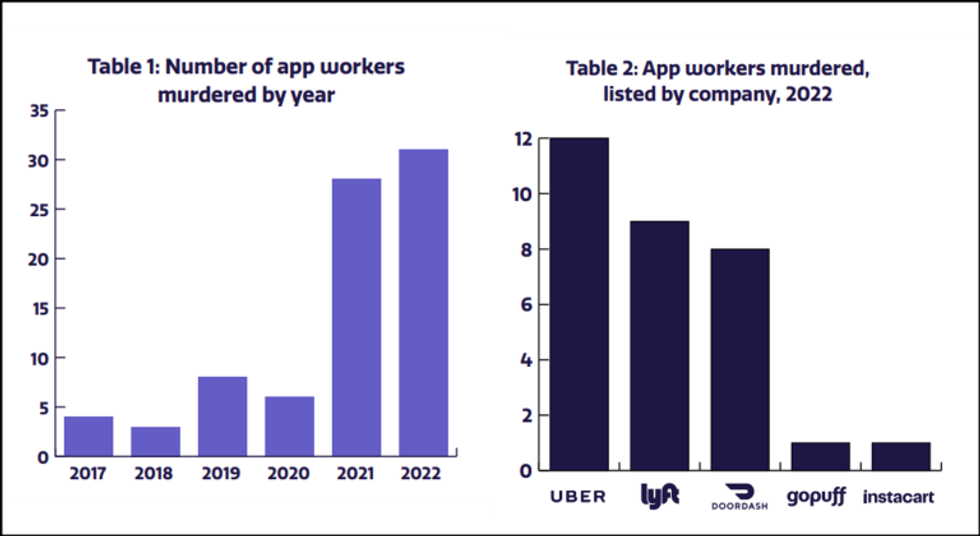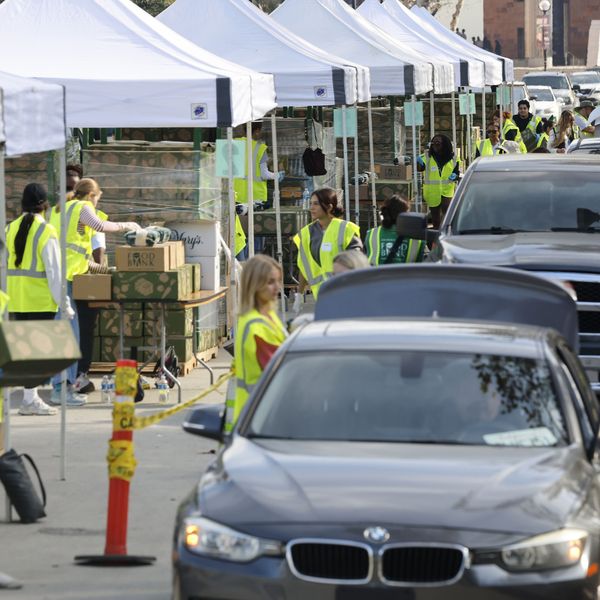
The Uber phone app is shown as cars drive by in Washington, D.C.
Gig Workers Know Best How to Fix the Gig Economy's Failure
Drivers know what will keep them safe: fair pay, job security, and solidarity.
In recent months, stories of rideshare drivers and delivery workers carjacked, robbed, or even killed on the job have made headlines around the country. Now, growing research shows that there is an all-out, racialized safety crisis in app-based work.
On May 1—May Day—Gig Workers Rising, PowerSwitch Action, and ACRE released new research that suggests the safety crisis among app workers—especially app workers of color—is escalating. The organizations found that in 2022, at least 31 app workers —77 percent of whom were people of color—were murdered while working. That’s more app workers murdered than we have been able to identify in any prior year. Last year, when Gig Workers Rising first raised the alarm about this crisis, they found that just over 50 app workers were murdered on the job over the five years prior. Now, after just one more year, the total is more than 80.
It’s heartbreaking, it’s unacceptable—and it can be fixed.

What makes app work so dangerous? App-based corporations like Uber and Lyft rely on a business model that shifts responsibility for safety on the job to drivers and pushes them into dangerous situations. Here’s how the model puts drivers at risk.
App worker pay is often low and unpredictable. In a 2022 national survey, 64 percent of respondents reported earning less than $15 per hour, and many drivers make less than minimum wage. To make ends meet, many workers rely on incentives, such as bonuses and surge pay, which require completing a specific number of rides or orders within a set timeframe, putting pressure on them to work at any cost.
Further, Uber and Lyft can “deactivate”—essentially terminate—workers for any reason, leaving them suddenly unemployed and without income, often without meaningful recourse. Recent surveys show that temporary and permanent deactivation are a regular occurrence for many app workers. This model fuels the pressure on workers to keep working even when they feel unsafe and not rock the boat with customers who could get them deactivated with a complaint.
This pressure to keep working, even when feeling unsafe, disproportionately affects drivers of color. In a recent national survey, 56 percent of drivers of color reported continuing a ride that made them feel unsafe because they were concerned an increased cancellation rate could lead to deactivation; 70 percent reported they had done the same out of concern that a negative customer review would lead to the same consequence. The sense of apprehension is justified, as 69 percent of drivers of color in a recent California survey reported experiencing some form of deactivation, and workers can be deactivated for low acceptance or high cancellation rates.
As the largest app corporation in the world, Uber has both a responsibility and an opportunity to make meaningful changes to address the safety crisis drivers face. Not only is the corporation not rising to the occasion, but in 2022 Uber paid CEO Dara Khosrowshahi more than $1 million and four other executives another $1.3 million for “safety improvements.” Uber did this even though the corporation failed to meet even its own narrow safety metrics, which did not encompass the broad range of widespread violence many drivers face.
The solutions to the safety crisis won’t be found in executive bonuses. Instead, Uber must address the risks created by low pay, unfair termination, and other elements of their model. And the company has the resources to do so, as it marked a record $31.8 billion in revenue in 2022—it just needs to find the will.
Drivers know what will keep them safe: fair pay, job security, and solidarity. On May 4, thousands of rideshare drivers across the country—in Seattle, San Francisco, Los Angeles, Chicago, Denver, and New York—are coming together to take action to demand that Uber improve safety by ending unfair driver terminations and paying drivers fairly for their work. All Uber has to do is follow their lead.
An Urgent Message From Our Co-Founder
Dear Common Dreams reader, The U.S. is on a fast track to authoritarianism like nothing I've ever seen. Meanwhile, corporate news outlets are utterly capitulating to Trump, twisting their coverage to avoid drawing his ire while lining up to stuff cash in his pockets. That's why I believe that Common Dreams is doing the best and most consequential reporting that we've ever done. Our small but mighty team is a progressive reporting powerhouse, covering the news every day that the corporate media never will. Our mission has always been simple: To inform. To inspire. And to ignite change for the common good. Now here's the key piece that I want all our readers to understand: None of this would be possible without your financial support. That's not just some fundraising cliche. It's the absolute and literal truth. We don't accept corporate advertising and never will. We don't have a paywall because we don't think people should be blocked from critical news based on their ability to pay. Everything we do is funded by the donations of readers like you. Will you donate now to help power the nonprofit, independent reporting of Common Dreams? Thank you for being a vital member of our community. Together, we can keep independent journalism alive when it’s needed most. - Craig Brown, Co-founder |
In recent months, stories of rideshare drivers and delivery workers carjacked, robbed, or even killed on the job have made headlines around the country. Now, growing research shows that there is an all-out, racialized safety crisis in app-based work.
On May 1—May Day—Gig Workers Rising, PowerSwitch Action, and ACRE released new research that suggests the safety crisis among app workers—especially app workers of color—is escalating. The organizations found that in 2022, at least 31 app workers —77 percent of whom were people of color—were murdered while working. That’s more app workers murdered than we have been able to identify in any prior year. Last year, when Gig Workers Rising first raised the alarm about this crisis, they found that just over 50 app workers were murdered on the job over the five years prior. Now, after just one more year, the total is more than 80.
It’s heartbreaking, it’s unacceptable—and it can be fixed.

What makes app work so dangerous? App-based corporations like Uber and Lyft rely on a business model that shifts responsibility for safety on the job to drivers and pushes them into dangerous situations. Here’s how the model puts drivers at risk.
App worker pay is often low and unpredictable. In a 2022 national survey, 64 percent of respondents reported earning less than $15 per hour, and many drivers make less than minimum wage. To make ends meet, many workers rely on incentives, such as bonuses and surge pay, which require completing a specific number of rides or orders within a set timeframe, putting pressure on them to work at any cost.
Further, Uber and Lyft can “deactivate”—essentially terminate—workers for any reason, leaving them suddenly unemployed and without income, often without meaningful recourse. Recent surveys show that temporary and permanent deactivation are a regular occurrence for many app workers. This model fuels the pressure on workers to keep working even when they feel unsafe and not rock the boat with customers who could get them deactivated with a complaint.
This pressure to keep working, even when feeling unsafe, disproportionately affects drivers of color. In a recent national survey, 56 percent of drivers of color reported continuing a ride that made them feel unsafe because they were concerned an increased cancellation rate could lead to deactivation; 70 percent reported they had done the same out of concern that a negative customer review would lead to the same consequence. The sense of apprehension is justified, as 69 percent of drivers of color in a recent California survey reported experiencing some form of deactivation, and workers can be deactivated for low acceptance or high cancellation rates.
As the largest app corporation in the world, Uber has both a responsibility and an opportunity to make meaningful changes to address the safety crisis drivers face. Not only is the corporation not rising to the occasion, but in 2022 Uber paid CEO Dara Khosrowshahi more than $1 million and four other executives another $1.3 million for “safety improvements.” Uber did this even though the corporation failed to meet even its own narrow safety metrics, which did not encompass the broad range of widespread violence many drivers face.
The solutions to the safety crisis won’t be found in executive bonuses. Instead, Uber must address the risks created by low pay, unfair termination, and other elements of their model. And the company has the resources to do so, as it marked a record $31.8 billion in revenue in 2022—it just needs to find the will.
Drivers know what will keep them safe: fair pay, job security, and solidarity. On May 4, thousands of rideshare drivers across the country—in Seattle, San Francisco, Los Angeles, Chicago, Denver, and New York—are coming together to take action to demand that Uber improve safety by ending unfair driver terminations and paying drivers fairly for their work. All Uber has to do is follow their lead.
- We Are Dancing on the Very Edge of Hell ›
- Opinion | The Gig Economy Is a Working-Class Nightmare | Common Dreams ›
In recent months, stories of rideshare drivers and delivery workers carjacked, robbed, or even killed on the job have made headlines around the country. Now, growing research shows that there is an all-out, racialized safety crisis in app-based work.
On May 1—May Day—Gig Workers Rising, PowerSwitch Action, and ACRE released new research that suggests the safety crisis among app workers—especially app workers of color—is escalating. The organizations found that in 2022, at least 31 app workers —77 percent of whom were people of color—were murdered while working. That’s more app workers murdered than we have been able to identify in any prior year. Last year, when Gig Workers Rising first raised the alarm about this crisis, they found that just over 50 app workers were murdered on the job over the five years prior. Now, after just one more year, the total is more than 80.
It’s heartbreaking, it’s unacceptable—and it can be fixed.

What makes app work so dangerous? App-based corporations like Uber and Lyft rely on a business model that shifts responsibility for safety on the job to drivers and pushes them into dangerous situations. Here’s how the model puts drivers at risk.
App worker pay is often low and unpredictable. In a 2022 national survey, 64 percent of respondents reported earning less than $15 per hour, and many drivers make less than minimum wage. To make ends meet, many workers rely on incentives, such as bonuses and surge pay, which require completing a specific number of rides or orders within a set timeframe, putting pressure on them to work at any cost.
Further, Uber and Lyft can “deactivate”—essentially terminate—workers for any reason, leaving them suddenly unemployed and without income, often without meaningful recourse. Recent surveys show that temporary and permanent deactivation are a regular occurrence for many app workers. This model fuels the pressure on workers to keep working even when they feel unsafe and not rock the boat with customers who could get them deactivated with a complaint.
This pressure to keep working, even when feeling unsafe, disproportionately affects drivers of color. In a recent national survey, 56 percent of drivers of color reported continuing a ride that made them feel unsafe because they were concerned an increased cancellation rate could lead to deactivation; 70 percent reported they had done the same out of concern that a negative customer review would lead to the same consequence. The sense of apprehension is justified, as 69 percent of drivers of color in a recent California survey reported experiencing some form of deactivation, and workers can be deactivated for low acceptance or high cancellation rates.
As the largest app corporation in the world, Uber has both a responsibility and an opportunity to make meaningful changes to address the safety crisis drivers face. Not only is the corporation not rising to the occasion, but in 2022 Uber paid CEO Dara Khosrowshahi more than $1 million and four other executives another $1.3 million for “safety improvements.” Uber did this even though the corporation failed to meet even its own narrow safety metrics, which did not encompass the broad range of widespread violence many drivers face.
The solutions to the safety crisis won’t be found in executive bonuses. Instead, Uber must address the risks created by low pay, unfair termination, and other elements of their model. And the company has the resources to do so, as it marked a record $31.8 billion in revenue in 2022—it just needs to find the will.
Drivers know what will keep them safe: fair pay, job security, and solidarity. On May 4, thousands of rideshare drivers across the country—in Seattle, San Francisco, Los Angeles, Chicago, Denver, and New York—are coming together to take action to demand that Uber improve safety by ending unfair driver terminations and paying drivers fairly for their work. All Uber has to do is follow their lead.
- We Are Dancing on the Very Edge of Hell ›
- Opinion | The Gig Economy Is a Working-Class Nightmare | Common Dreams ›

